Posted by R. John Howe on 06-01-2003 08:23 AM:
A Well-Designed Salon, Worth Taking On
Dear folks and Tom -
I have been away since May 14 and so just read
Tom's salon this morning.
I am not a collector of Baluch pieces and don't
really study the distinctions being made, but do remember DeWitt Mallory, the
NYC Baluch collector, coming to the TM a few years ago and saying that, if he
had given his talk that day ten years previously, he would have a lot more to
say about Baluch weaving. But, he continued, we have discovered that:
1.
We do not know who the "Baluch" were for sure.
2. We suspect now that many
pieces that we call "Baluch" were not in fact woven by Baluch weavers.
3.
With on or two exceptions we are not sure where most "Baluch" rugs were woven
(Tom seems to disagree about this aspect).
4. And with one or two exceptions
we are not sure who wove the rugs we call "Baluch."
He then gave a
presentantion and a walk-through of the exhibition drawn from the Jeff Boucher
collection (which Mallory had curated) that was noteworthy for me in what it did
not attempt to say about the pieces. It was very, very bland indeed and I think
deliberately so, since DeWitt's position on Baluch weaving that day seemed to
accentuate a claim that things had actually gone backward with regard to
knowledge as learning about "Baluch" weaving advanced. [Very different from the
claims of Jerry Anderson during Tom's interview with him or of the seemingly
aggressive attributions in Michael Craycraft's older writings. (Michael told me
once that he had taken Jon Thompson to task for giving up prematurely on his
"Imreli" claims, which Michael thinks are correct.)]
I've seen something
similar happening with some Turkmen analysis. I see more pieces labeled
"Turkmen" without a tribal attribution nowadays and some of the "gods" of
Turkmen analysis have begun to say "not Ersari" without indicating what the
alternative might be.
Now while I've slipped into talking about
"attribution" in this last paragraph or two, I'm clear that Tom is advising that
he thinks it is more advisable to talk about "provenance," and I want to say,
most centrally in this post, that I admire the design of this salon and mean to
embarrass myself publicly in the next week or so, by taking on its useful
task.
I have designed a few salons with such tasks and think that taking
them on, as posed, is likely a useful undertaking. I notice that many simply
ignore such salon tasks and continue with the (largely) speculative
conversations that we seem to find most comfortable. Or we move the conversation
in other directions entirely.
Anyway, as an old instructional designer, I
admire and welcome the experiential design of Tom's salon here. Actually taking
on the task it poses will likely be a healthy, if humbling,
experience.
Regards,
R. John Howe
Posted by Henry_Sadofsky on 06-01-2003 10:05 PM:
Hi John, and all,
“I admire and welcome the experiential design of
Tom's salon here. Actually taking on the task it poses will likely be a healthy,
if humbling, experience.” You betcha’ …
Of the 15 images which precede
the “quiz”, the first (call it “A”) is a detail from a prayer rug (in a private
collection) that was displayed at James Blackmon’s exhibit that coincided with
the Burlingame ACOR. The rug is like no other ‘Baluch’ I have seen, and is, in
my opinion, a most interesting, intriguing, and desirable one. That- in spite of
Tom’s opinion that it is merely “distinctly brown with limited use of colour”.
In fact, it could be argued that what the ‘Baluch’, using a limited
(beautifully rich and glowing) color palette, were able to accomplish in their
weavings, is what is truly remarkable and distinctive about the ‘Baluch’
aesthetic. What is one to make of ‘Baluch’ weavings which have a gay palette but
not the mystery, soulful-ness, “eye-wink” and shimmer of what many think of as
‘Baluch’? Of course, this is not to say that all gaily colored ’Baluch’ pieces
lack these qualities.
Of the following 14 images- the 1st, 5th, 6th,
8th, 10th (call them “B”, “E”, “F”, “H”, “J”) are reminiscent (and perhaps, in
some cases, identical to) pieces that have appeared on e-bay over the past 3
years. These gaily-colored pieces are certainly of a different aesthetic than
what Boucher thought a “Baluchi” should look like. He, rather, would almost
certainly have considered them to be “Baluchi in name only”. As, nowadays, we
are not certain how ‘Baluch’ Boucher’s “Baluchi”s are, nor how non-“Baluchi” his
“… in name only” is- a different classification system would certainly be
welcome.
Tom has proposed that ‘Baluch’ weavings be classified as to
their origin in Khorassan, western Afghanistan, or Seistan. Should available
data make this possible, it would indeed be “a real source of comfort” for both
dealers and collectors. More importantly, such a framework could clarify methods
and avenues for further research.
Before discussing the next grouping of
images in Tom’s presentation it should be pointed out that the text implies that
images “M” and “N” are reversed.
On to the quiz ... I am pretty sure that
I would like #s 7, and 10. I cannot tell enough about #s 1, 2, 8, and 12 (from
the images provided) to form an impression. I suspect that I would feel not
particularly disposed to #s 5, 9, and 11. I am pretty sure that I would dislike
#s 3, 4, 6, and 9. I would also note that the quiz does not include an appealing
image of a “classic” ‘Baluch’ (i.e. perhaps what #12 is meant to represent).
Where are the pieces from? I do not know. I do know, at least for some
of them, where some authorities think they are from. Tellingly, there does not
seem to be consensus amongst these authorities (both current and past). This
raises the question as to which authority one might rely on? The answer to that
is, I believe, simple and straightforward. One may rely on the authority that
presents sufficient data, and data analysis, such as to convince one of the
integrity of the data and the conclusions drawn from it.
In the “Color!”
thread Tom responded to an inquiry of Chuck Wagner’s regarding one of Chuck’s
rugs with: “The muted palette suggest NW Afghanistan rather than NE Persia,
somehow” We might agree that neither “muted palette” nor “somehow” is either
precise or convincing.
About some of the other pieces Tom has
authoritatively replied:
“#10 IS a w. Afghanistan weaving
…”
“Number 2 is not Khorassan... too diverse of a palette… “
“The
latch hook design seen in #7 is a CLASSIC Seistan region rug… As is #3, another
classic pattern seen in Seistan.”
I am hoping that at some point in this
Salon Tom will share with us the data/observations that allow him to reach these
conclusions.
Posted by Henry Sadovsky on 06-01-2003 10:18 PM:
Addendum:
I forgot to point out that Tom's proposed classification system is logically
flawed. Khorassan and Seistan are names which stem from two thousand years ago,
whereas Afghanistan is a modern creation. The problem is that these areas are
not distinct. Part of western "Afghanistan" is contained in "Khorassan" (Herat
was the capital of Khorassan), and part is contained in "Seistan".
Logically consistent alternatives include:
a) NE Iran, NW
Afghanistan, and SW Afghanistan. The problem with this is that it does not
include SE Iran, or W. Pakistan.
b) Western Khorassan, Eastern Khorassan,
and Seistan. The problem with this is that it is archaic.
Of these two
alternatives, I prefer "b" as it is the more inclusive one.
Posted by Steve Price on 06-02-2003 06:48 AM:
I apologize
Hi People
A few messages up, you'll see one from "Henry_Sadofsky". The
name includes a typographical error I made when posting it for Henry Sadovsky. I
apologize to Henry for this.
Regards,
Steve Price
Posted by Tom Cole on 06-03-2003 11:36 AM:
Henry:
You have written-----
“In the “Color!” thread Tom responded to
an inquiry of Chuck Wagner’s regarding one of Chuck’s rugs with: “The muted
palette suggest NW Afghanistan rather than NE Persia, somehow” We might agree
that neither “muted palette” nor “somehow” is either precise or convincing.”
----
I agree with you. Obviously I was not pretending to be precise or
convincing. But if you want to pin me down. I will suppose that rug is from
Afghanistan. I am accustomed to observing a more saturated palette in Khorassan
weavings (palette is a product of provenance) and this piece pictured by Chuck
appears to exhibit characteristics of Afghan work. But now Chuck has informed us
the rug is symmetric knotted… which leaves me totally in the dark.. no opinion
at all. The symmetric knotted Baluch rugs are not within my field of knowledge
at all. There are exceptions to every rule and I am just guessing, not etching
my thoughts in stone as irrefutable facts.
You continue
----
“About some of the other pieces Tom has authoritatively replied:
“#10
IS a w. Afghanistan weaving …”
“Number 2 is not Khorassan... too diverse of a
palette… “
“The latch hook design seen in #7 is a CLASSIC Seistan region rug…
As is #3, another classic pattern seen in Seistan.”
I am hoping that at
some point in this Salon Tom will share with us the data/observations that allow
him to reach these conclusions.”
Let me offer some data/observations
which allow me to reach these conclusions -
Re: #10. The coarser weave (you
have not had the opportunity to see the back), the border system (again not seen
here) and the handle, end finish on the flatwoven closures, all suggest an
Afghan provenance. And I originally purchased it in Afghanistan, many years ago,
in a village in western Afghanistan from the people whose ancestors had actually
woven it. So I hope that clarifies matters for you.
Re: #2… again you
have not seen the entire piece. It is a detail from a khorjin which exhibits the
distinctive knotted pile ‘shoulders’ which connect the two pile bags, shoulders
of a continuous border design in pile. A feature ONLY seen in khorjin (donkey
bags) from Seistan. And, to my knowledge, in my experience, there are no
Khorassan weavings with this type of colour, with such a clear aubergine ground,
with green and that type of orange/red.
Re: #7, please refer to Rugs of
the Wandering Baluch for a similar example, plate 37. These rugs are from
Seistan region. How do I know? Because I have purchased them on the other side
of the border in Pakistan from traders who have brought them from houses in
villages located in Seistan. The traders bought them from the people whose
families had woven them in Seistan, from people who had always lived in Seistan.
These “main rugs” appear in the same long rug format, a main rug format that is
not seen elsewhere in Baluch rugs (rectangular or square shaped main rugs are
more common among the other groups). Why are their carpets this shape? The
weavers are a sedentary people who live in elongated mud houses; the rugs are
made to mimic the shape of their rooms. How do I know this? Murray Eiland, who
has traveled in Seistan told me of the shape of their houses as did Jerry
Anderson, privately, subsequent to the interview in HALI 76 in response to this
very query.
Same goes for #3. I have the same experience with pieces like
this as I have had with similarly patterned rugs as featured in #7, purchased
them from traders arriving from Seistan. In HALI 76, the interview with Jerry
Anderson, for all the unanswered questions it poses, it unequivocally carries an
air of authority. This is a man who traveled thoughout these areas and knows the
language, the people and the rugs. Rugs of this type, with this structure
(asymmetric knot open to the left), palette and design type were identified by
Jerry as rugs originally from the Seisan region of SE Persia. My own field
experience with traders bringing rugs from Persia supports this hypothesis as
well.
Regarding geographical names… we can indulge ourselves in
semantics, or we can just assume we agree about what we are all talking and take
it from there. Afghanistan is a somewhat modern creation in its PRESENT
political form, but there has always been a distinction between Persia and
Afghanistan as their languages, Dari and Farsi, while obviously related, are
different. And when one crosses the modern political border into Persia, the
dialect spoken changes.
Additionally, we can examine some old
travelogues and look for data that will support the geographic identifications
offered here.
While some of the borders of present day Afghanistan are
“modern” (ie. the Durand Line drawn on the eastern border, separating
Afghanistan from India in the latter part of the 19th century), Afghanistan has
existed as an entity, which includes some of the regions from which “Baluch”
rugs originate, for a long time. There is a book published in 1815 entitled, “An
Account of The Kingdom of Caubul" by Montstuart Elphinstone. He speaks of the
“Eimauks and Hazaurehs ….[who]… inhabit the Paropamisan Mountains between Caubul
and Heraut, having Uzbeks on their north and the Dooruanees [Pashtoon] and
Ghiljies [another Pashtoon tribe] on their south.” Elphinstone continues, “One
is surprised to find within the limits of Afghaunistaun, and that very part of
it which is said to be the original seat of the Afghauns, a people differing
entirely from that nation in appearance, language, and manners. The wonder seems
at first removed, when we find that they bear a resemblance to their Toorkee
neighbors, but points of difference occur even there, which leave us in more
perplexity than before. The people themselves afford us no aid in removing this
obscurity, for they have no account of their own origin; nor does their
language, which is a dialect of Persian, afford any clue by which we might
discover the race from which they sprung. Their features, however refer them at
once to the Tartar stock, and a tradition declares them to be the offspring of
the Moguls [Mongols?]. They are, indeed, frequently called by the name of Mogols
to this day, and they are often confounded with the Mogols and Chagatyes who
still reside in the neighborhood of Heraut. They themselves acknowledge their
affinity to those tribes as well as to the Calumuks now settled in Caubul, and
they intermarry with both of those nations. They do not, however, understand the
language of the Mogols of Heraut.”
Some interesting observations noted here,
no? Clearly this region east of Heraut was considered to be in the Kingdom of
Caubul [Kabul] at that time and it is a region that is certainly thought to be
an area from where some of the so-called Baluch weavings of Afghanistan
originate.
Regarding the history of Heraut and its relevance to studies
of Afghanistan, Elphinstone continues in his narrative. “[Heraut] gave its name
to an extensive province at the time of the expedition of Alexander, and it was
for a long time the capital of the empire, which was transmitted by Tamerlane to
his sons. From the house of Timour, it passed to the Suffavees of Perisia, from
whom it was taken by the Dooraunees [Pashtoons of Afghanistan] in 1715. It was
retaken by Naudir Shauh in 1731, and it fell into the hands of Ahmed Shauh in
1749 since which time it has been held by the Dooraunees.” I think we can safely
say that Heraut was considered a part of the political entitiy of Afghanistan as
it was recognized in the mid 18th century. Thus, calling it east Khorassan may
not be completely accurate, but we do all know what you are talking about,
splitting hairs is not necessary.
Henry.. you also wrote, “These
gaily-colored pieces are certainly of a different aesthetic than what Boucher
thought a “Baluchi” should look like. He, rather, would almost certainly have
considered them to be “Baluchi in name only”. As, nowadays, we are not certain
how ‘Baluch’ Boucher’s “Baluchi”s are, nor how non-“Baluchi” his “… in name
only” is- a different classification system would certainly be
welcome.”
Boucher lifted the phrase “in name only” from Michael
Craycraft’s “Baluch Prayer Rugs”, a moniker misattributed to the Colonel.
Michael’s most memorable observation, in my mind, on Baluch rugs and the maze of
attributions, etc. was to say these rugs are made in a “Baluch style”, which
includes Boucher’s Baluch and ‘in name only’ Baluch weavings. That is to say
they have a similar handle, wool quality, etc that identify them as having
emerged from a similar cultural mileau. The tribal names which inhabit the
Baluch nomenclature are real names of real tribes. But it is extremely difficult
to say which tribe wove which rugs as the data for that presumption is certainly
lacking, or at best, indefinite.
On the contrary, with Turkmen studies,
the history of the Turkmen is much more documented than that of the “Baluch” and
early travelers remarked upon the appearance of certain tribes in specific
areas. And thanks to the Russian explorers, ie. Dudin and other documents in
Russian museums with which very few have ever had direct access (at least very
few of us here in the western countries outside of Russia), specific rugs DO
have specific tribal attributions associated with them. The Turkmen tribes first
appeared in historical chronicles at an early date (14th century?). The Seljuks
of Anatolia are descended from the Turkmen and the interest in and impact of the
Seljuks on art in Anatolia and Central Asia is great. The Turkmen aesthetic is a
classical tribal art (if those two terms can be used in juxtaposition), while it
is still unclear what the aesthetic of Baluch rugs should be termed or is
viewed. Hence, the market uncertainty. It used to be that Baluch rugs were given
away free by dealers to their clients, thought to be derivative art and
irrelevant in the long run. The efforts to classify, identify, attribute, etc is
an exercise in establishing a legitimacy to these rugs. We yearn for stories in
the west, usually unable to simply believe our eyes as to what is art and
letting the artistic merits justify our evaluation of that rug (intellectual,
artistic and economic evaluation). In Afghanistan, as noted by Andrew Hale in
HALI 76, the story is free. The rugs aren’t, at least not these
days.
Additionally, the real Baluch of Baluchistan are not supposed to be
engaged in pile weaving, but instead concentrated their efforts on flat weaves.
They are not even called Baluch, but rather go by the name ‘Brahui’ It becomes
increasingly clear the name “Baluch” is somewhat meaningless in the context of
tribal attributions for rugs, but is extremely useful in terms of knowing what
‘style’ of rug it is about which we are discussing.
Posted by Henry Sadovsky on 06-03-2003 04:47 PM:
Geography and history of Khorassan and Seistan
HI Tom. I am most interested to explore these issues further with you and the
group. First, to assure that all start off "from the same page", I offer the
following texts on the geography and history of Khorassan and Seistan.
From: http://www.irancaravan.com/RPR.htm
quote:
Geographical Position, Khorassan Province
The (Iranian)
province of Khorassan, located in the northeast of Iran is the largest
province of the country; covering one-fifth of the area that is 303.000 sq.
km.(italics added). The townships of this province are Esfarayen,
Bardestan, Bojnurd, Birjand, Taibad, Torbat Jaam, Torbat Heydarieh, Chenaran,
Khaaf, Daregaz, Sabzevar, Sarakhs, Shirvan, Tabas, Ferdows, Fariman, Qaenat,
Quchan, Kashmar, Gonabad, Mashad, Mahbandar and Nayshabur. Mashad being the
capital city, where the shrine of his Holiness Imam Reza (AS) the eighth Imam
of the Shiite sect is situated.
Khorassan Province Position
In
1996 about 6 million people resided in Khorassan of which approximately 56.6%
resided in urban areas and 43.3% in rural sectors, the remaining were
non-residents. This province can be divided into two sections regarding its
natural features: The northern section which has a mountainous terrain, though
its lower plains are suitable for agricultural purpose and animal husbandry
.The southern section comprises of low hills and plains with poor vegetation.
Climate, Khorassan Province
Climatically this province is
variable in weather. Located in a north temperate zone, the temperature
increases from north to south but the annual rainfall decreases. For example
Aladaq and Binalood heights experience cold and mountainous weather, whereas
in some parts of Mashad a temperate, mountainous climate exists. Qaenat and
mountain side areas have a mild, semi-arid climate while the southern zones
are warm, dry and arid.
History and Culture, Khorassan Province
In the past history of Iran, the province of Khorassan has been a
constant witness to the rise and fall of powers and governments. Various
classes such as the Arabs, Turks, Mongols, Turkemen and Afqans have accounted
for much unaccountable events in this wide territory. The ancient geographers
of Iran had devided Iran (Iran Shahr) into eight segments, of which the most
flourishing and largest was territory of Khorassan. During the Sassanian
Dynasty the province was governed by a Espahbod (Lieutenant General) called
"Padgoosban" and four margraves, each commander of one of the four parts of
the province.
Khorassan was divided into four parts during the
Islamic period and each section was named after the four large cities, such as
Nayshabur, Marve, Harat and Balkh. In the year 31 AH, the Arabs came to
Khorassan and it was at this time that the inhabitants accepted the religion
of Islam. Till the year 205 AH, this territory was in the hands of the
Bani-Abbas clan, followed by the rule of the Taherian clan in the year 283 AH,
and there after in 287 AH the Samanian Dynasty came to the scene as rulers.
Sultan Mohmood Qaznavi conquered Khorassan in 384 AH and in the year 429 AH
Toqrol, the first of the Saljuqian Dynasty conquered Nayshabur.
Mahmood Qaznavi retaliated against the invaders several times, and
finally the Qaznavi Turks defeated Soltan Sanjar Saljuqi. But there was more
to come, as in the year 552 AH. Khorassan was conquered by Kharazm Shahian and
because of simultaneous attacks by the Mongols, Khorassan was annexed to the
territories of the Mongol Ilkhanan. In the (8th century AH, a flag of
independence was hoisted by the Sarbedaran movement in Sabzevar and in the
year 873 AH, Khorassan came into the hands of Amir Teimoor Goorkani and the
city of Harat was declared as capital. In the year 913 AH Khorassan was
occupied by the Ozbekans.
After the death of Nader Shah Afshar in 1160
AH, Khorassan was occupied by the Afqans. During Qajar period, Britain
supported Afqans as they were responsible for guarding the Indian Borders.
Finally, the Paris Treaty was concluded (1903) and Iran was compelled not
to interfere in the internal affairs of Afqanistan. At this time Khorassan was
divided into two: the eastern part, which was the most densely populated
region came under Britain’s protection, and the other western section remained
under the occupation of Iran.
From: http://www.iras.ucalgary.ca/~volk/sylvia/Seistan.htm
The
Vanished Paradise of Seistan
Quoted from:
George Curzon,
Persia and the Persian Question, vol 1 (1892)
quote:
The derivation of the name Seistan or Sejestan from Sagastan, the country of
the Sagan, or Sacae, has, says Sir H. Rawlinson, never been doubted by any
writer of credit, either Arab or Persian ; although it is curious that a band
of roving nomads, as were these Scythians, who descended hither from the north
in the third century A.D., should have bequeathed a permanent designation to a
country which they only occupied for a hundred years. (Some English writers,
however, have derived it from saghes, a wood that is grown locally and is used
as fuel by the Persians.) Expelled by the Sassanian monarch Varahran II (A.D.
275 -292) they have long vanished from history themselves; but in the name of
the district they may claim a monumentum oare perennius.
At different
epochs of history territories of very differing sizes have been called
Seistan, according as the dominion of their rulers has been extended or
curtailed. In its stricter application, however, the name has always been
peculiar to the great lacustrine basin that receives the confluent waters of
the Helmund and other rivers, whose channels converge at this point upon a
depression in the land's surface, with very clearly defined borders, and a
length from north to south of nearly 250 miles. It is certain that in olden
days this depression was filled by the waters of a great lake; and, were all
the artificial canals and irrigation channels, by which the river-contents are
now reduced and exhausted, to be destroyed, I imagine that it would very soon
relapse into its primeval conditions.
The modern Seistan may be said
to comprise three main depressions, which, according to the season of the year
and the extent of the spring floods, are converted alternately into lakes,
swamps, or dry land. The first of these depressions consists of the twofold
lagoon formed by the Harut Rud and the Farrah Rud flowing from the north, and
by the Helmund and the Khash or Khushk Rud flowing from the south and east
respectively. These two lakes or pools are connected by a thick reedbed called
the Naizar, which, according to the amount of water that they contain, is
either a marsh or a cane-brake. In flood time these two lakes, ordinarily
distinct, unite their waters, and the conjoint inundation pours over the
Naizar into the second great depression, known by the generic title of Hamun
or Expanse, which stretches southwards like a vast shallow trough for many
miles. When the British Commissioners were here in 1872, the Hamun was quite
dry, and they marched to and fro across its bed. But in 1885-6, when some of
the members of the later Russo-Afghan Boundary Commission were proceeding this
way from Quetta to the confines of Herat, it was found to be an immense lake,
extending for miles, with the Kuh-i-Khwajah, a wellknown mountain and
conspicuous landmark usually regarded as its western limit, standing up like
an island in the middle. In times of abnormal flood the Hamun will itself
overflow; and on such occasions the water, draining southwards through the
SaTshela ravine, inundates the third of the great depressions to which I
alluded, and which is known as the Zirreh Marsh. This was said at the time of
the Commission not to have occurred within living memory, it being a far more
common experience to find all the river-beds exhausted than all the lake-beds
full ; and the Zirreh as a rule presents the familiar appearance of a salt
desert. In 1885, however, a British officer exploring Western Beluchistan
found water two feet deep flowing down the Sarshela or Shela, and forming an
extensive Hamun in the northern part of the Zirreh, which was said to be over
one hundred miles in circumference.
It will readily be understood from
the above description how variable is the face of Seistan, and what a puzzle
to writers its Protean comparative geography becomes. For not only do the
lakes alternately swell, recede, and disappear - the area of displacement
covering an extent, according to Rawlinson, of one hundred miles in length by
fifty miles in width - but the rivers also are constantly shifting their beds,
sometimes taking a sudden fancy for what has hitherto been an artificial
canal, but which they soon succeed in converting into a very good imitation of
a natural channel, in order to perplex some geographer of the future. It is
not surprising, therefore, that while the country owes to the abundant
alluvium thus promiscuously showered upon it its store of wealth and
fertility, it also contains more ruined cities and habitations than are
perhaps to be found within a similar space of ground anywhere in the world.
Such in brief outline is the physical conformation of Seistan. I will
now proceed to its history. From the earliest times there has been something
in Seistan that appealed vividly to the Persian imagination. The country was
called Nimroz, from a supposed connection with Nimrod, 'the mighty hunter'; it
was the residence of Jamshid, and the legendary birthplace of the great
Rustam, son of Zal, and fifth in descent from Jamshid. King Arthur does not
play as great a part in British legend as does the heroic Rustam in the myths
of Iran. For, after all, Arthur was a mortal man (and, if we are to follow
Tennyson, almost a nineteenth century gentleman), while Rustam fought with
demons and jinns as well as against the pagan hordes of Turan and Afrasiab.
Perhaps our Saint George of the Dragon would be a nearer parallel; and just as
we stamp the record of his matchless daring upon our coinage, so do the
Persians emblazon the great feats of Rustam upon gateway and door and pillar.
Seistan emerges into the clearer light of ascertained history in the
time of Alexander the Great, when it was known as Drangiana (identical with
the land of the Herodotean Sarangians). He probably passed this way on his
march eastwards to India; whilst on his return therefrom, though he pursued a
more southerly line himself, through Gedrosia (Mekran) to Carmania (Kerman),
he despatched a light column under Craterus through Arachotia and Drangiana.
Under the Sassanian monarchs Seistan was a flourishing centre of the
Zoroastrian worship, and hither came the last sovereign of that dynasty,
Yezdijird, flying from the victorious Arabs on his way to his fate at Aferv.
It was under the succeeding regime that the province attained the climax of
its material prosperity; and to this-the Arab-period are to be attributed the
vast ruins of which I have previously spoken. In the ninth century a native
dynasty known as the Sufari or Coppersmiths, was founded by one Yakub bin
Leitb, a potter and a robber, but a soldier and a statesman who won by arms a
shortlived empire that stretched from Shiraz to Kabul, but collapsed before
the iron onset of Mabmud of Ghuzni in the succeeding century. El Istakhri,
visiting Seistan at this epoch, described it as a country of populous cities,
abundant canals, and great wealth; among its natural resources being included
a rich gold mine that subsequently disappeared in an earthquake. In the
thirteenth and fourteenth centuries Seistan, like most of its neighbours,
experienced the two successive visitations of those scourges of mankind,
Jenghiz Khan and Timur Beg, being turned from a smiling oasis into a ruinous
waste, and suffering a murderous blow from which it has never recovered. The
Sefavi dynasty repeopled it under the local rule of the ancient reigning
family of Kaiani, who claimed descent from Kai Kobad, the first Achaemenian
king. But the march of time brought round the fated cycle of injury and
desolation; and at the bands both of the Afghan invaders of 1722, and of Nadir
Shah who expelled them, it completed its chronic tale of suffering. Remaining
a portion of the mighty empire of the Afshar usurper till his death in 1747,
it then passed to the sceptre of Ahmed Shah Abdali, the adventurous captain
who, imitating his master's exploits, rode off and founded the Durani empire
in Afghanistan. From this epoch dates its appearance on the stage of modern
politics, and during the last thirty years upon the chess-board of
Anglo-Indian diplomacy . . .
Posted by Henry Sadovsky on 06-03-2003 07:07 PM:
Geography
Tom- you said: "Regarding geographical names… we can indulge ourselves in
semantics, or we can just assume we agree about what we are all talking and take
it from there." To be clear, you are refering to alternatives on how to
distinctly divide the large area of 'Baluch' weaving (more on that later) into
three regions.
Three possibilities have been presented here:
-
Khorassan/W. Afghanistan/Seistan
- N.E. Iran/N.W. Afghanistan/S.W.
Afghanistan
- W. Khorassan/E. Khorassan/Seistan.
I disagree with your
characterization of this aspect of the problem as a semantic one. This is a
matter of geography. Objective facts are readily available to clarify the issue.
I see no justification (such as might be the case if a particular scheme was
traditional or commonly accepted) that would warrant perpetuation of a flawed
choice.
Posted by Tom Cole on 06-03-2003 10:18 PM:
You may call an area that was never 'ruled' by anyone, much less those in
Herat by the name East Khorassan. I do not care.. it is all semantics to me...
names on a map are semantics.. the geography is unchanged as is the history.
That area where these rug weaving groups live/lived is what it is... w.
Afghanistan or E. Khorassan... take your choice... it does not change the
landscape of Baluch studies very much.
Posted by Henry Sadovsky on 06-04-2003 02:38 AM:
A desert landscape?
Hi Tom. The geography issue is rather clear to my mind and I will not press
the point further. As for "the landscape of Baluch studies", all are free to
decide whether it is parched or fecund.
You wrote:
quote:
"Boucher lifted the phrase 'in name only' from Michael Craycraft’s “Baluch
Prayer Rugs”, a moniker misattributed to the Colonel. Michael’s most memorable
observation, in my mind, on Baluch rugs and the maze of attributions, etc. was
to say these rugs are made in a “Baluch style”, which includes Boucher’s
Baluch and ‘in name only’ Baluch weavings.
Interesting... My quick review of "Belouch Prayer Rugs" did
not locate this phrase ("in name only") or concept ("Baluch Style"). In fact,
Michael wrote (in the Introduction): "Anybody who has observed many Belouchi
weavings is soon overwhelmed by the lack of any cohesive unity in style,
design and method of end finishing."
Nevertheless, it is certainly the
current paradigm (yes I have read Kuhn's book) that there exists a large body of
piled weavings which, while not the products of Baluch peoples, nonetheless
follow closely the Baluch tradition. Hence, Azadi's title: "Carpets in the
Baluch tradition".
I daresay that titling this Salon “Baluch aesthetics”,
as well as the following two quotes, has not diminished the confusion which is
present in the landscape of Baluch studies. You wrote:
quote:
Additionally, the real Baluch of Baluchistan are not supposed to be
engaged in pile weaving, but instead concentrated their efforts on flat
weaves. They (i.e. the real Baluch) are not even called
Baluch, but rather go by the name ‘Brahui’ (emphasis and italics added).
Baluch vs. 'Baluch'? Merely semantics?
I quote you
again Tom:
quote:
It becomes increasingly clear the name “Baluch” is somewhat
meaningless in the context of tribal attributions for rugs, but is extremely
useful in terms of knowing what ‘style’ of rug it is about which we are
discussing.
I believe that analysis of this last statement is needed,
but I am now going to bed.
Posted by Steve Price on 06-04-2003 06:10 AM:
I say Germany, they sayDeutschland
Hi Tom,
Your wrote, They (i.e. the real Baluch) are not even called
Baluch, but rather go by the name ‘Brahui’.
This isn't critical to
any of your major points, of course, but before anyone takes off running with
this as a subtopic I would like to point out that what we call people and what
they call themselves is seldom the same.
The only modification I'd make
in your sentence is to leave out the word "even", which implies that there
something bizarre about us calling them Baluch. It's far less peculiar than us
calling the Deutsch "Germans", or the French calling the Nihonjin
"Japonaise".
Regards,
Steve Price
Posted by Tom Cole on 06-04-2003 09:35 AM:
Henry.. sorry.. the 'in name only' moniker was from the associated
exhibition, and guess it never made it into the catalogue.. but in any case it
was a phrase Michael used early and often to which proper credit is
due.
And regarding clarification of a Baluch "style" of weaving....I
wrote, "these rugs are made in a “Baluch style”, which includes Boucher’s Baluch
and ‘in name only’ Baluch weavings. That is to say they have a similar handle,
wool quality, etc that identify them as having emerged from a similar cultural
mileau."
Seems pretty clear.. it is again, as I stated, a phrase or
concept coined by Michael Craycraft, and seems very useful in that it opens the
door for eliminating endless theories concerning specific tribal attributions,
some of which may be impossible to determine.
Perhaps my approach is
inevitably flawed... I am not so concerned with exactly who wove what , but
prefer looking at them and judging them on their artistic merits, a simplistic
approach I guess. For those with a more mathematical, analytical methodology, I
am guessing what I write is rather uninteresting and possibly irrelevant.
Posted by Steve Price on 06-04-2003 10:00 AM:
Hi Tom,
Your wrote, Perhaps my approach is inevitably flawed... I
am not so concerned with exactly who wove what , but prefer looking at them and
judging them on their artistic merits, a simplistic approach I guess. For those
with a more mathematical, analytical methodology, I am guessing what I write is
rather uninteresting and possibly irrelevant.
I'd say that every
approach is inevitably flawed in the real world, but that doesn't make any of
them uninteresting or irrelevant. I believe one of the strengths of the format
we use here is that it brings many approaches to bear on the issues. We learn
from each other through our interactions, and I think most of us broaden and
sharpen (a difficult combination to achieve!) the way we think about rugs and
textiles in the process.
Regards,
Steve Price
Posted by Chuck Wagner on 06-04-2003 11:12 AM:
Baggage
Hi Tom,
If I read your previous post correctly, the photos below
should be of a Sistan va Baluchistan donkey bag. This is what you mean by piled
shoulders, right ?:
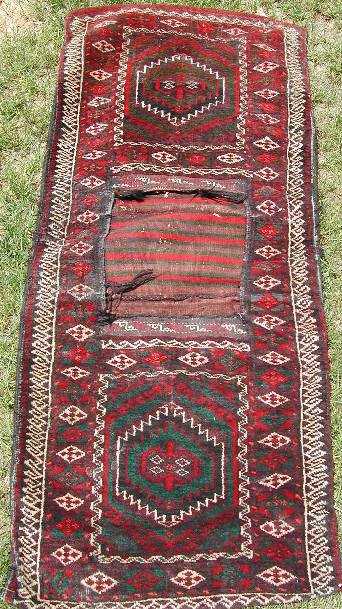

It
has highlights in a strange pinkish orange that looks synthetic, but, on the
pleasant side of synthetic. The green in the closeup is uncomplicated and
probably synthetic as well (it doesn't look like a yellow-over-blue job). But at
the other end of the bag it's a more variegated olive tone; a different batch of
wool, and maybe an overdye.
I understand where you're trying to go (I
think) by abstracting to the provincial or regional level. Dick Parsons also
groups Baluch and Baluch-type weavings in the same chapter of his book, with
equal emphasis on geography and tribal association. Tribal attributions ARE
often quite tenuous. But Sistan va Baluchistan probably contains 80% of the
Baluchis in Iran. There must be some variations in color/design/weave that can
be classified further and at a lower level, within the "greater Sistan"
category.
It would be helpful if you elaborated a little more on how you
go about classifying Baluch-type weavings. You mentioned in the Salon that you
use color as the primary criterion for provenance SOME pieces, but you didn't
really explain how you see the "whole world" of Baluch-type weavings and how you
decide which go into the "color bin". A brief note was made of iconography and
weave, but more should be said (I think). I think we'd all benefit from an
overview of your broader perspective, and how & when color becomes the
dominant factor.
Regards,
Chuck
__________________
Chuck
Wagner
Posted by Henry Sadovsky on 06-04-2003 12:00 PM:
For two points:
Baluch/Brahui, German/?
a) Deutschlander
b)
German-American
c) Spaniard
d) Maori
Posted by Tom Cole on 06-04-2003 12:13 PM:
Chuck- You are right, your khorjin is from Seistan, as the pile 'shoulders'
are a distinctive Seistan Baluch feature. You are also correct that within
Seistan itself, some differences in palette and design occur that seem to be
suggest different groups. For example, there is a corroded blue dye that occurs
in some weavings, not all from Seistan, and it is a colour that, in my
experience, is confined ONLY to this area as I have not seen it in Khorassan
weavings.
Regarding all the criterion by which one might use to judge
all the divisions, etc. between the rugs, it is complex. Some of it is based on
structure, ie. the reason I stated all the rugs in the "quiz" were asymmetric
knotted open left. Which is why YOUR rug with symmetric knots is confusing to
me. So, often it is based on a variety of factors including colour, structure,
design, etc. In this forum, as in HALI 97, I tried to simplify things... more so
than what will withstand the closest and most sceptical scrutiny. For example,
the colour issue is clouded by related groups inhabiting different regions,
sharing similar colour sensibilities, but with different formats and patterning
(ie. Chakhansur and Seistan, two different areas with related aesthetics in
terms of colour and some motifs). The main rug format in Chakhansur is NOT the
long rug format of Seistan, but they will often share some designs (ie. latch
hook 'mushwani' medallions) and both will tend towards a more colourful palette
than that used in Khorassan.
Posted by Sophia Gates on 06-04-2003 02:10 PM:
Seeking Answers, We Find Questions!
Chuck, Henry, Tom, et. al.,
Whoa. I think I've already learned more
about this region and these weavings than I'd previously known.
So -
therefore I now know considerably LESS than I did a few hours ago - if that
makes sense -
Some questions:
1. Wouldn't it be helpful for people
who have some of these Seistan - and other non-typical "Baluch" pieces to start
analyzing them structurally, then perhaps we could pool our resources and see if
we can come up with a database?
2. I don't think we can discuss color
and ignore design. The Seistan pieces seem to have different design ideas from
the Khorossan pieces. I had a classic prayer tree piece, for example, with a
camel ground - classic Baluch piece - finely woven, camel/red/blue - I sold it
but I have pix which I might send to Steve later once I've secured permission
from the new owner. In the meantime, I think everybody knows what I'm
discussing.
I also have 3 Seistan region pieces, two I got from Tom and
one locally - two are balishts and one is a bag like Chuck's. They obviously
come from a completely different design pool than the prayer rug - AND their
color is different. They feel different too - longer pile, so forth.
Structurally they aren't the same at all!
I am beginning to think we
should not even be classifying these things as Baluch - we do need - sorry! - to
try to figure out who these folks were/are!
3. I'm curious, of course,
WHY things evolve as they do. So - question for the historians: do we know to
what extent the people in these various areas relied upon the services of
professional dye masters? Regardless of familial or tribal affiliations, it
strikes me that people in various areas might have had different habits
regarding the use of professionally dyed yarns. Local fashion might have played
a role in color choice also. But, I think this is something that could be
researched - in fact, probably is long overdue: the history and economic and
artistic impact of the dye masters on the tribal/village rugs in Iran and along
the path of the Silk Road.
I've been told this was primarily a Jewish
trade. So, perhaps there are resources available, not necessarily in the history
of rugs, but in Jewish historical sources.
I can't help but come to the
hypothesis that the more gaily color "Baluches" might have been made by people
with access to professional dye shops. Although I personally find the more
subdued Baluch pieces very beautiful, and appreciate them also for their very
subtle intricacies of design, I like the somewhat coarser yet more "colorful"
Seistan pieces as well. And those colors strike me as presenting a challenge to
the people making them.
Thanks in advance to all,
Sophia
PS: on
the topic of esthetics: I think it's natural for the weavers of the more
intricate, finely woven Khorossan pieces to have chosen a more subtle palette.
That way the drawing wouldn't be overwhelmed by the color. Also, one has to
assume they made a choice, a conscious decision, not to use more "gay" color -
perhaps they found it unsuitable for what they were trying to express. The
limiting factor, of course, would have been their access or lack thereof to
professional dye masters. On the other hand, perhaps they DID buy professionally
dyed wool and rejected the bright colors on purpose.
In other words,
bright colors are not necessarily BETTER colors. Color has such a tremendous
impact emotionally, people wanting to express other ideas, more sombre thoughts,
mathematical intricacies, etc - which do show up in the more subtle Baluch
weavings - will automatically and deliberately choose more sombre colors.
Posted by Henry Sadovsky on 06-04-2003 06:21 PM:
Soul
Hi Sophia. You are so sensible and you write so beautifully. I was just
thinking:
- If you are between 18 and 65 y.o.
- Not currently
betrothed
- Willing to relocate to Utah, while,
- I convince my only
current wife to do the same,
then maybe we should talk
privately.
With regard to your questions:
1. Yes! An excellent
example of this type of effort is what Bob Pittenger has done with regard to
Blue-ground prayer rugs. Until the method yields sufficient data as to allow a
consensus on specific points of provenance/attribution, it would be most logical
to start with a purely descriptive category of the items that were to be further
analyzed. For example, one such effort could be directed to "gaily colored pile
weavings in the 'Baluch' tradition".
2. Agreed. A fairly safe prediction
is that with such an effort as you describe one would end up wondering why they
ever thought the different groups were of the same family. As you have noted,
different groups of 'Baluch' weavings can differ in wool, pile, design pool,
color, weave (and, I would add: hand, handle, and emotional
temperature/sensibility/impact). This is what Michael Craycraft was getting at
in the statement from the Intro of "Belouch Payer Rugs" I quoted earlier. As you
probably know, Michael rarely sees Baluch pieces (note absence of quotation
marks)!
3. Pass
Note to your P.S
My intuition (FWIW) suggests
to me that the choice of a limited, "somber" (it is nothing of the sort to me)
palette in "classic"/red-and-blue/Boucher-type 'Baluch' weavings was a very
basic and deep one.
I agree totally that "bright colors are not
necessarily BETTER colors." The color of really good "classic 'Baluch' weavings
is unsurpassed to my eye. I cannot say that I get the same sense of awe from
even the best "gay" 'Baluchs'.
Posted by Sophia Gates on 06-05-2003 12:33 PM:
A Passion For Color
Dear Henry,
May I bring my cats?
Sigh. Back to Intellectual Matters:
I agree totally with Henry about the deep colors, the dignity of the "classic"
Baluches. I think they're marvelous. And, I believe they represent a completely
different idea of color and design than the gaily colored pieces - not the
result of having forgotten how to make bright colors - or "lateness" - but the
result of many deliberate choices resulting in a restrained, elegant, classical
esthetic.
So with these other textiles, it seems we have another idea - a
different sort of expression. Tom, if possible could we please see the whole
pieces? Whereas the fragments show color, they don't show the entire design -
and as I said above, I think it's important that we understand the
interrelationship of color with the other elements of design.
And - who,
ahem, wants to start keeping a database of structural information? We already
have a start!
As for the information concerning who these people were or
are - I'm going to poke around the 'net a bit, see if I can hook up with a
university - possibly even in Iran.
One of my hobbies is reading
mysteries. One of my favorite mystery authors is Tony Hillerman, who writes
about my beloved home in the Southwest, and focuses especially on the Dineh -
the Navajo people. In his latest, he has a hilarious passage concerning gold
mines, how the Dineh very carefully directed the belagaani - the white folks -
in exactly the wrong direction when they asked the location of possible gold
deposits. So, I'm sure the information is out there, about who these Seistan
weavers were - but we must seek it through proper channels, so to
speak.
Best to all,
Sophia
Posted by Chuck Wagner on 06-05-2003 05:28 PM:
Department Of Gay Dark Muted Colorful Rugs
Hi Sophia, et all..
First a couple residual images from the Sistan
donkey bag, to partially address your interest in technical structure. This
particular bag is currently on the other side of the planet from me, so I can't
give you the gory details right now. I can say that this piece has a blue-gray
cotton weft.
In this shot of the back, note the heavy ribbed character
and partial knot depression, a characteristic that I often see in Irani Baluchi
products. Afghan Baluchi stuff rarely has any knot depression, in my
experience:
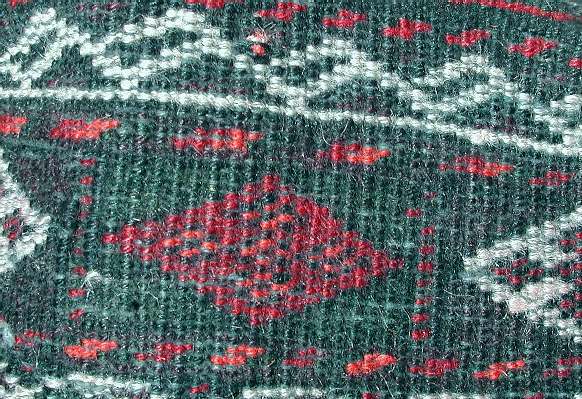
And a shot of the medallion from the other end of the bag
showing a very different green:
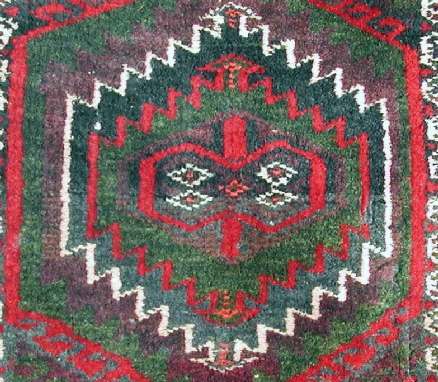
In fairness to myself, the color
combinations on this bag are not attractive to me. But it's an unusual piece for
the market here, I like the kilim work at the bag opening, and it looks nice on
a wall, from a distance.
Now, for an Afghani rug with Bipolar
Disorder; call me crazy, but I love this one, despite the fact that it
demonstrates how hard it is to get good photos of carpets. Both film and digital
cameras have different color sensitivity that the human eye, and trying to
either emphasize, or faithfully represent, certain rugs (like THIS one) can be a
real PITA. 
.....But
after taking LOTS & LOTS & LOTS of shots I got some that I like... 
This piece
addresses several prior talking points:
1) Some rugs that are inside
should really be outside to be appreciated
2) Contrary to the general public
perception, Baluch rugs CAN and DO have colour
3) Green, in older Baluchi
goods, generally sources from the areas peripheral to the Dasht-i-Margo and
Sistan deserts.
4) If Mushwanis wove rugs, what might they look like ?
5)
Bright colors are not necessarily better colors
6) The statement "the OLD
ones from Afghanistan have PLENTY of colour and are never dark, mysterious or
without colour contrast" probably should not contain the word
"never"
And one new talking point:
1) Swamp-edge dwelling
wives of goat-herding drug smugglers have interesting, if not quirky, ideas
about color
The images:
Indoor shot, modest lighting:
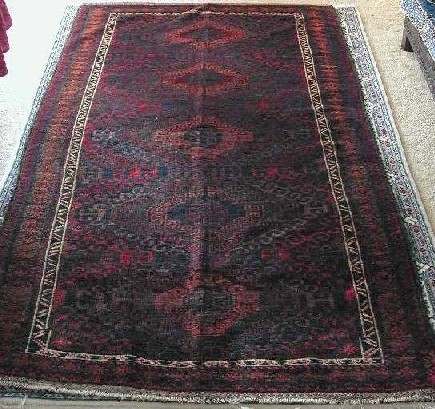
Outdoor shot,
overcast sunlight:
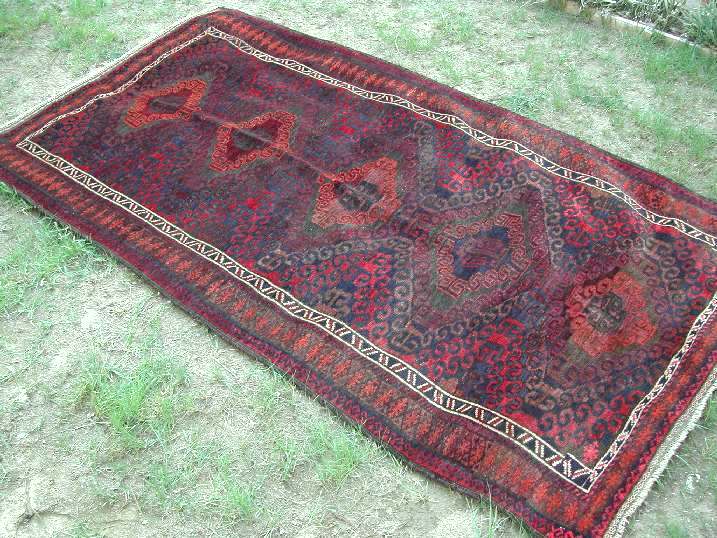
A closeup of one corner, in bright sunlight:
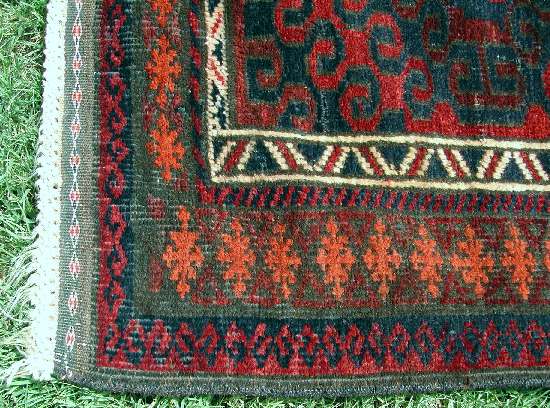
A shot of the bottom
end of the rug at a weird angle so the colors could be brought out (more because
of the camera's sensitivities; it looks darker to the naked eye. Indirect
light):
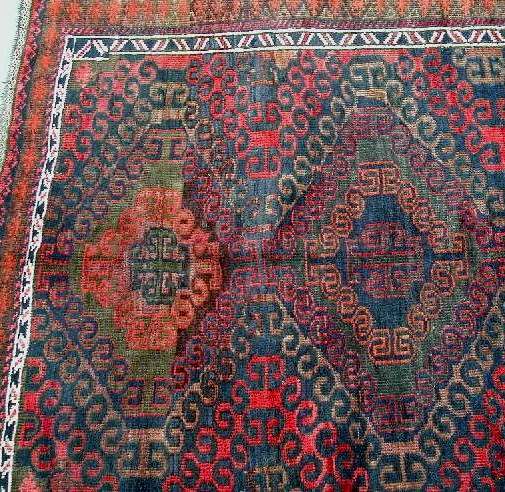
A closeup of the green area, showing the rose/maroon
outlines of the latch hooks (bright sunlight):
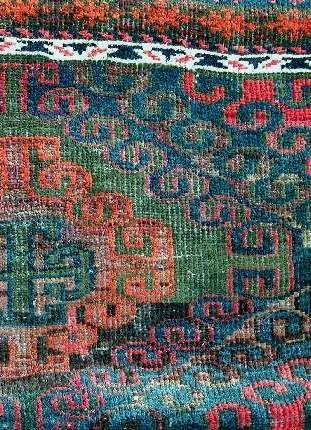
An ode to Sophias
structure thing. Haiku:
Knots: 9V x 6H asymmetrical open to the left,
Warp : Ivory wool Z2S
Weft : Brown wool, 2 shoots, each Z
spun
(Note that the pile yarn is quite thin):

And finally, one for Yon. One
bright green knot, the only one in the rug:

Regards,
Chuck
__________________
Chuck
Wagner
Posted by Filiberto Boncompagni on 06-06-2003 04:25 AM:
Chuck and all,
The structure of your Sistan donkey bag is the same of
a modern Iranian Balouch of mine. Same ribbed back, blue-gray cotton weft. Mine
has symmetrical knots.
I spare you the pictures because the rug is in
storage.
I submit to you all, instead, the picture of one I
missed.
It looked like an old Balouch prayer rug, classical floppy
handle, soft and lustrous wool, rather classical tree-of-life design, ends gone,
very reasonable priced…The pastel-pink palette stunned me.
See
why?
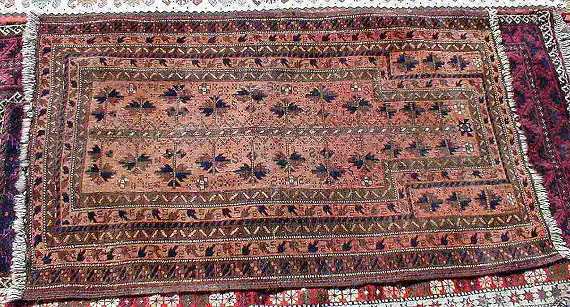
Being
accustomed to the dark colors of old Balouchis I suspected a chemical wash, so I
took a picture and decided to think about it overnight.
The day after it was
gone.
Now I saw that Balouch rugs can have different palettes.
At the
moment I‘m beginning to doubt it was chemically washed…
Mournfully,
Filiberto
Posted by Henry Sadovsky on 06-06-2003 03:39 PM:
A rose is a rose is a rose?
Hi Filiberto. Sometimes (mourned) missed opportunities turn out (in
hindsight) to have been (fortuitously) avoided errors in judgement.
The
rug you show seems to me to not be a "real thing". (Tom, was it you who taught
me that phrase)? By that, I mean to say that it does not appear to me to have
been woven with either passion or conviction. It lacks "spark", personality, "a
face". To me, this indicates that it is a late weaving (nothing particualrly
wrong with that) that is detached from the cultural context that "inspired it"
(not the kind of thing that is "collectible"). Just my
opinion...
Provocatively yours,
Henry
Posted by Chuck Wagner on 06-06-2003 03:59 PM:
Filiberto,
In Parsons' book on Afghan rugs, there is a photo of an old
Baluchi rug (plate 93a) with a subtle rosy pink that looks similar to that in
your picture. He explains it as a product of dye oxidation. I think you probably
would have seen color deep in the pile, in the case of a chemical wash.
I have seen one or two rugs that had been completely soaked with salt
water (in one case) and strongly alkaline city water (the second case) and both
had a similar tone in what was left of the red dyes. I presume that these were
acid dyes and were strongly suceptible to an alkaline bath.
And for Tom,
a question:
Are you aware of, and do you have any examples of, flatweaves
that have colors similar to the pile pieces you show in the Salon ?
I have
seen several Baluchi kilims with soft red tones and the usual blues and whites,
but never any of the pastel shades or green. And, of course, the really dark
ones.
Regards,
Chuck
__________________
Chuck
Wagner
Posted by Robert Alimi on 06-06-2003 04:59 PM:
Interesting salon. It seems that most everyone agrees (including Edwards,
Wegner and Boucher) that the only "Baluch" classification scheme that could make
any sense is a regional one. Given the large number of "identified" tribes, and
given that some tribes apparently had no qualms about changing their name (e.g.,
to show allegiance to a new khan), the tribal waters can get pretty darn murky.
A regional approach seems like a good idea. That said, using Wright/Wertime’s
"anchor piece" approach might be a logical next step. Tom mentioned owning some
rugs of known provenance. Are there other candidate "anchor pieces" out
there?
As for palette, I'd agree with those folks who think that the
darker and somewhat limited palettes can be a wonderful thing too. When the wool
and dyes are really excellent, these rugs can be elegant; but it does require
good lighting. I think if you did a survey of ruggies who are extremely
knowledgeable about interior lighting options, you'd find that the most
knowledgeable among them are "Baluch"
collectors!
Regards,
-Bob
Posted by Henry Sadovsky on 06-06-2003 05:16 PM:
Drool, drool...
Hi Chuck. You asked Tom: "Are you aware of, and do you have any examples of,
flatweaves that have colors similar to the pile pieces you show in the Salon"?
That's like asking Jerry Seinfeld if he knows where to get a good corned
beef sandwich. As soon as Tom stops drooling he will have much info for you. :
)
Hi Robert. I like your post very much, and agree with all of it except
for the implication of: "As for palette, I'd agree with those folks who think
that the darker and somewhat limited palettes can be a wonderful thing too".
Not only can they be have a wonderful palette "too"- some may find them
to be unsurpassed (Seljuk carpets excepted).
Posted by Chuck Wagner on 06-07-2003 03:16 PM:
Call 1-800-Provenance
Hi All,
Since we're supposed to be on the subject of "non-dark" Baloch
and Beloutsch-like weavings, I'd like to toss this one out for
comment:

It's
about 10 feet long and 4 feet wide. I'm at a loss to explain this piece; someone
who ought to know says it's Baluchi, maybe dating 1940s to 1950s. Someone else
who ought to know says he thinks it's more like 1920s and is more likely an
unspecified nomadic Afghan transhumant. Both agree that the weaver may have seen
Turkoman weavings at one time, either through a fog or from a great
distance.
The color scheme is simple. I think it's probably a synthetic
red, but I'm uncertain. There is more color at the base of the pile than on top.
It looks like it's seen a lot of sunlight over the years. I guess I would say
the tips look "paler" rather than "faded" (a very subjective characterization, I
admit). The warps are handspun light gray wool (very unusual for Baluchi work),
and the wefts are 2 shoots of handspun brown wool.
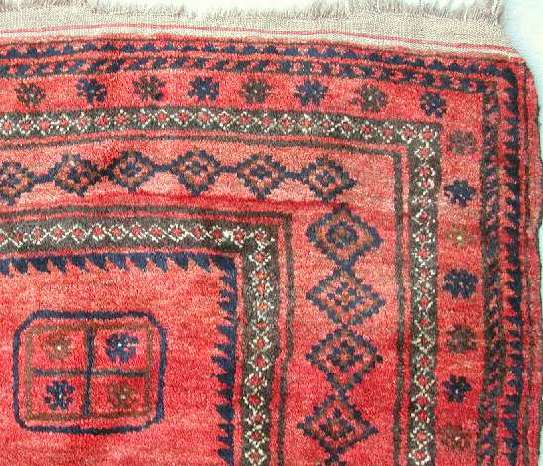
The weave does have a "sort of
Baluchi" look to it, asymmetrical open to the left:

And, the weaver had the skills
to handle distortions caused by uneven loom tensions, etc. :
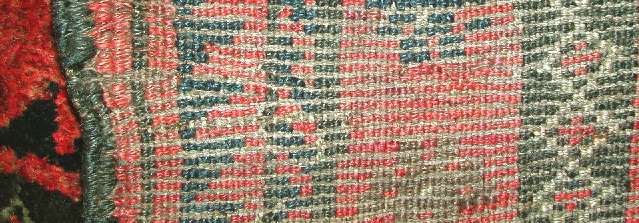
Any ideas
?
Regards,
Chuck
__________________
Chuck
Wagner
Posted by Tom Cole on 06-07-2003 04:19 PM:
Chuck... the rug is a Baluch from w. Afghanistan, something the dealers out
there would call 'Taimani', late as you say, a practical floor rug.
Posted by Vincent Keers on 06-07-2003 08:25 PM:
Cotton
This 1's for John:
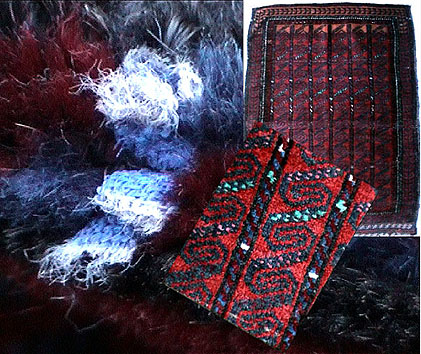
It isn't the greatest bagface on earth, but it has "rags" in.
Cotton rags
as you can see. And some strange colours in cotton.
as if she was getting
tired of all the red,brown,blue.
The pink (at the top) isn't faded. It's
front, back and inside pink.
For all,
Dark, pastel or whatever. Don't
think there's a law that dictates anything.
These weavers used everything
they could lay their hands on.
The clean, fixed new pakistan stuff seems to
be more colourful.
"Beloudch" bags, all original, but no mileage to
them.
Did anyone mention Uzbek? The embroideries are veeerrry
colourful.
And because my new camera works so nice, a "pioenroos" from my
garden. No colour.
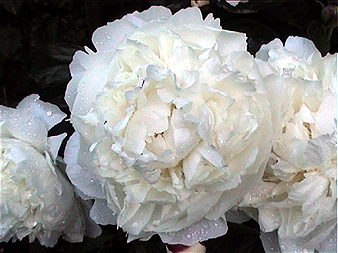
Best regards,
Vincent
Posted by R. John Howe on 06-08-2003 09:33 AM:
Thanks, Vincent -
Who would have thought it: a Balouch weaver at the
edge of rag rugs. The folks on the "rug talk" board (where they talk SERIOUSLY
about rag rugs, and especially about weaving them) would love
it.
Regards,
R. John Howe
Posted by R. John Howe on 06-22-2003 06:49 PM:
What I Heard and What I Decided
Dear folks -
As the initiator of this thread I need to deliver on a
promise I made when I started it. Please note that as I began this post, I see
that Tom may have provided the "book" answers to his exercise, but I have not
looked at it. Instead, I have simply tried to "brief" his beginning resource
guidance and then to apply it in the task he provided.
Two sorts of
errors at least are possible.
1. That I have not understood properly what
Tom has recommended in his resource.
2. That I have not applied these
rules properly in my decisions and/or in the associated rationales.
One
part at a time.
First, this is what I heard in summary.
I think
Tom has recommended about four or so distinctions with his rules. For me they
are:
1. Khorasan: bright red color. Sometimes orange-red or
magenta.
Afghan rugs from this area have warmer more yellow reds.
2.
Seistan: Greens, brighter blues, camel colored wool. Later pieces can lack
contrast.
3. Arab Balouch: darker, murkier, monochromatic (although a
more generous use of white seems present in one earlier? example)
4.
Doctor-i-gazi: complex but stiff and mechanical drawing (not a color
indication); associated Afghans are "colorful, pretty."
So the first
question is whether I got what Tom said right. I found it hard to take in his
argument at points and so there may be errors.
Now, my indications, using
the rules above.
Rug 1: Khorasan: clear, brilliant red
Rug 2: Seistan:
brown-red, camel color, some green
Rug 3: Seistan: green, brighter
blue
Rug 4: Earlier Arab Balouch: use of white, less monochromatic
Rug 5:
Later Arab Balouch: darker, mechanical
Rug 6: Khorasan: aubergine, clear
orange-red
Rug 7: Seistan: brown-red, green, camel color
Rug 8: Khorasan:
bright, clear red
Rug 9: Seistan: brown-red, camel color
Rug 10: Afghan
Balouch: color palette similar to resource example that was contrasted w/
doctor-i-gazi. Purple-red, medium blue.
Rug 11: Seistan: green, brown-red,
camel color
Rug 12: Khorasan: clear red
Regardless of my score I
should also report that I found Rug 4 and Rug 7 the most difficult to
decide.
Regards,
R. John Howe




















